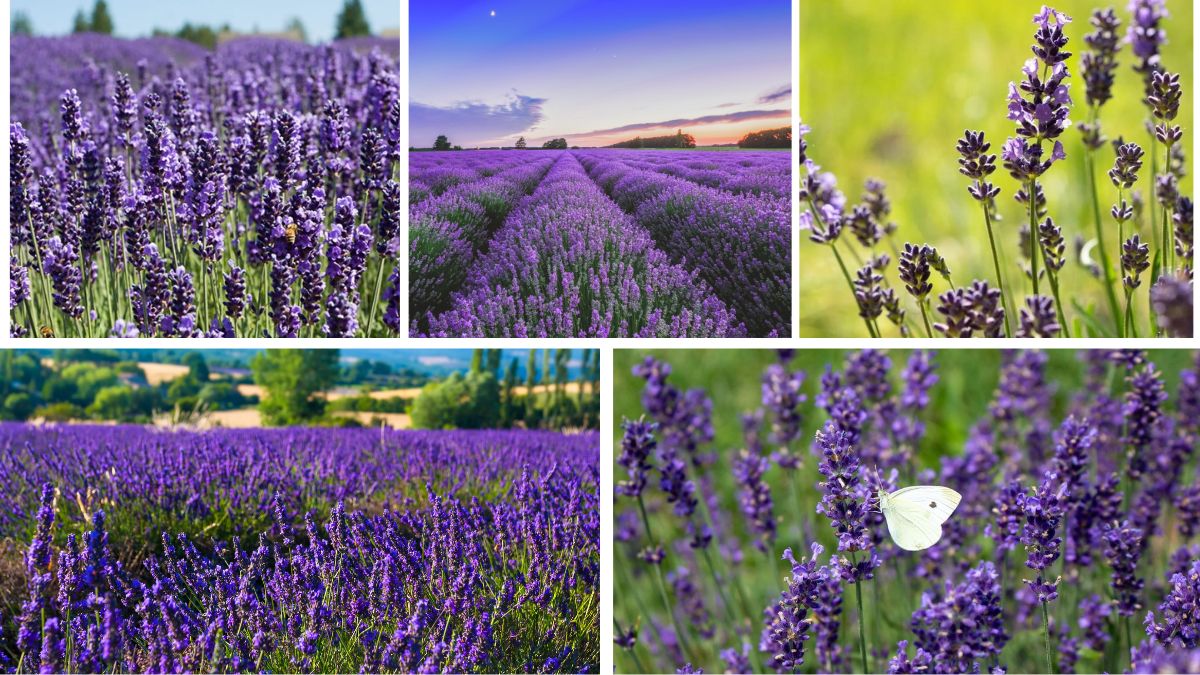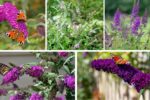Lavender (Lavandula spp.) is one of the most iconic and versatile plants in the world of gardening and agriculture. Known for its soothing fragrance, vibrant purple flowers, and wide-ranging uses in aromatherapy, culinary applications, and landscaping, lavender fields have become a symbol of beauty and tranquility. Whether you dream of creating a small backyard patch or a sprawling lavender farm, proper planting and maintenance are key to ensuring healthy, abundant blooms. This guide provides a complete overview of how to plant and maintain lavender fields successfully.
Why Grow Lavender Fields?

Lavender offers numerous benefits:
- Aromatic Beauty: Lavender’s distinctive fragrance is used in essential oils, soaps, and perfumes.
- Culinary Uses: Flowers and leaves can be used in teas, baked goods, and flavoring for various dishes.
- Attracts Pollinators: Bees, butterflies, and other beneficial insects are naturally drawn to lavender.
- Low Maintenance: Once established, lavender is drought-tolerant and pest-resistant.
- Economic Potential: Lavender fields can support agritourism, essential oil production, and dried flower sales.
With proper planning, a lavender field can be both visually stunning and highly productive.
Choosing the Right Lavender Variety
Selecting the appropriate lavender variety depends on climate, soil, and intended use. Some popular varieties include:
- English Lavender (Lavandula angustifolia): Sweet fragrance, ideal for culinary and aromatic uses; hardy in cooler climates.
- French Lavender (Lavandula dentata): Distinctive toothed leaves, suited for ornamental and essential oil purposes; prefers warmer climates.
- Spanish Lavender (Lavandula stoechas): Unique flower shapes with petal “ears,” attracts pollinators; thrives in sunny areas.
- Lavandin (Lavandula x intermedia): Hybrid of English and Portuguese lavender, high essential oil yield, vigorous growth.
Choose a variety suited to your local climate and soil conditions for the best results.
Selecting the Ideal Site
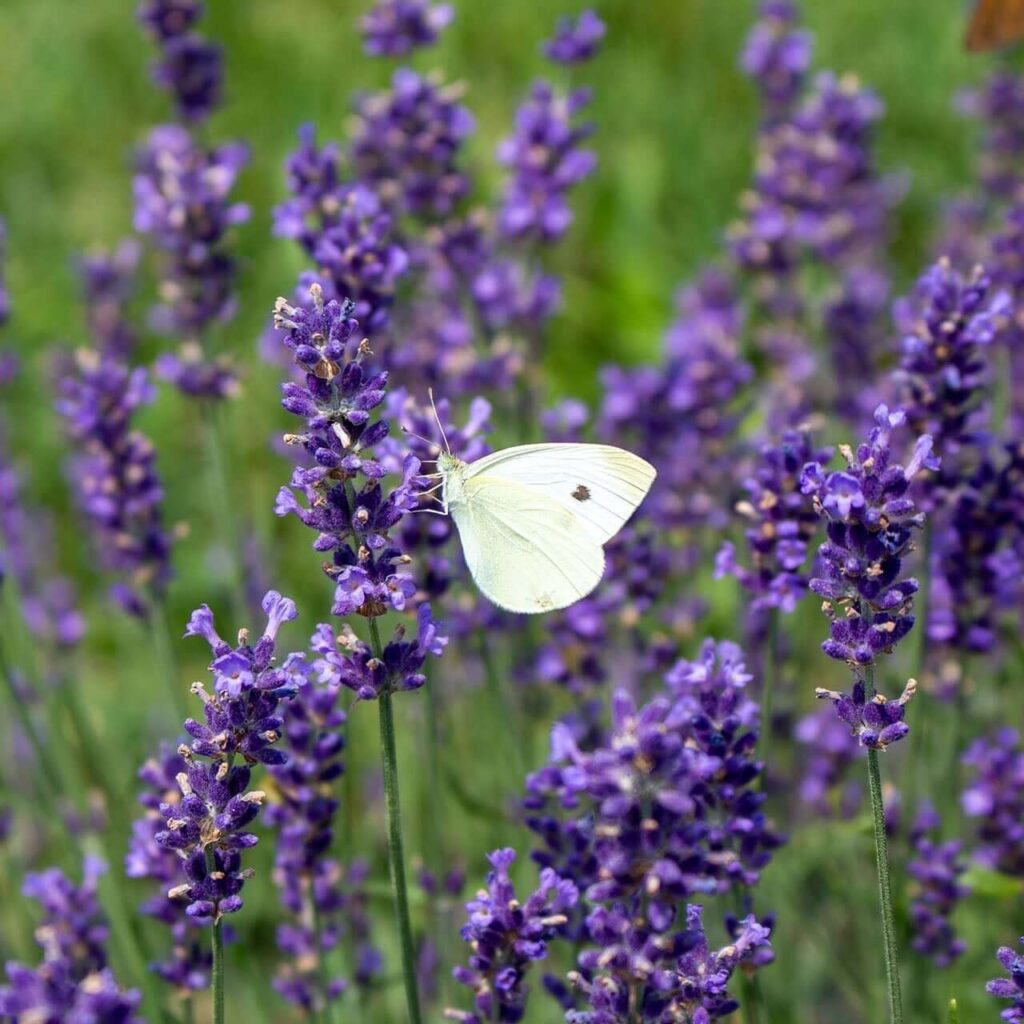
Lavender thrives in well-drained soil and sunny conditions. Key site considerations include:
- Sunlight: Full sun exposure (6–8 hours per day) ensures strong growth and abundant blooms.
- Soil: Sandy or loamy soil with excellent drainage; avoid clay or waterlogged areas.
- Airflow: Good circulation reduces the risk of fungal diseases like root rot and gray mold.
- pH Level: Slightly alkaline to neutral soil (pH 6.5–7.5) supports healthy growth.
Raised beds or sloping land can improve drainage and promote healthy root development.
Preparing the Soil
Proper soil preparation is critical for lavender success:
- Clear Weeds and Debris: Remove existing vegetation to reduce competition for nutrients.
- Improve Drainage: Add sand, gravel, or perlite to heavy soils.
- Add Organic Matter: Mix in compost or well-rotted manure to improve fertility without over-enriching the soil.
- Adjust pH if Necessary: Lime can be added to raise soil pH in acidic soils.
Lavender prefers nutrient-poor to moderately fertile soil, as overly rich soil can promote leaf growth at the expense of flowers.
Planting Lavender
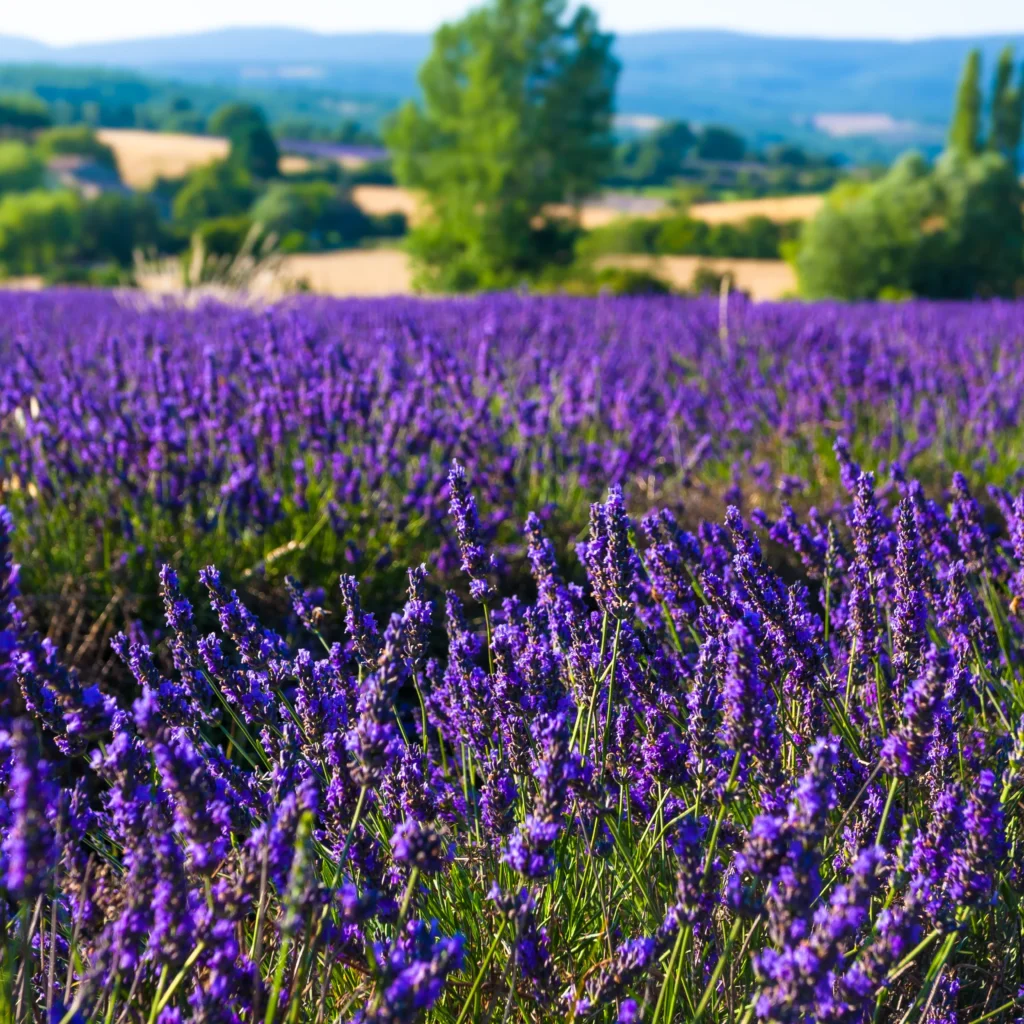
1. Spacing
- For field planting, space plants 2–3 feet apart in rows with 3–4 feet between rows to allow airflow and access for harvesting.
- Closer spacing is suitable for small ornamental gardens or container planting.
2. Planting Steps
- Dig holes slightly larger than the root ball.
- Place the plant so the crown is just above soil level.
- Backfill with soil and firm gently.
- Water thoroughly after planting to settle the roots.
3. Timing
- Plant in spring or early fall to allow roots to establish before extreme temperatures.
Tip: Avoid planting in wet or frost-prone conditions, which can damage young plants.
Watering and Irrigation
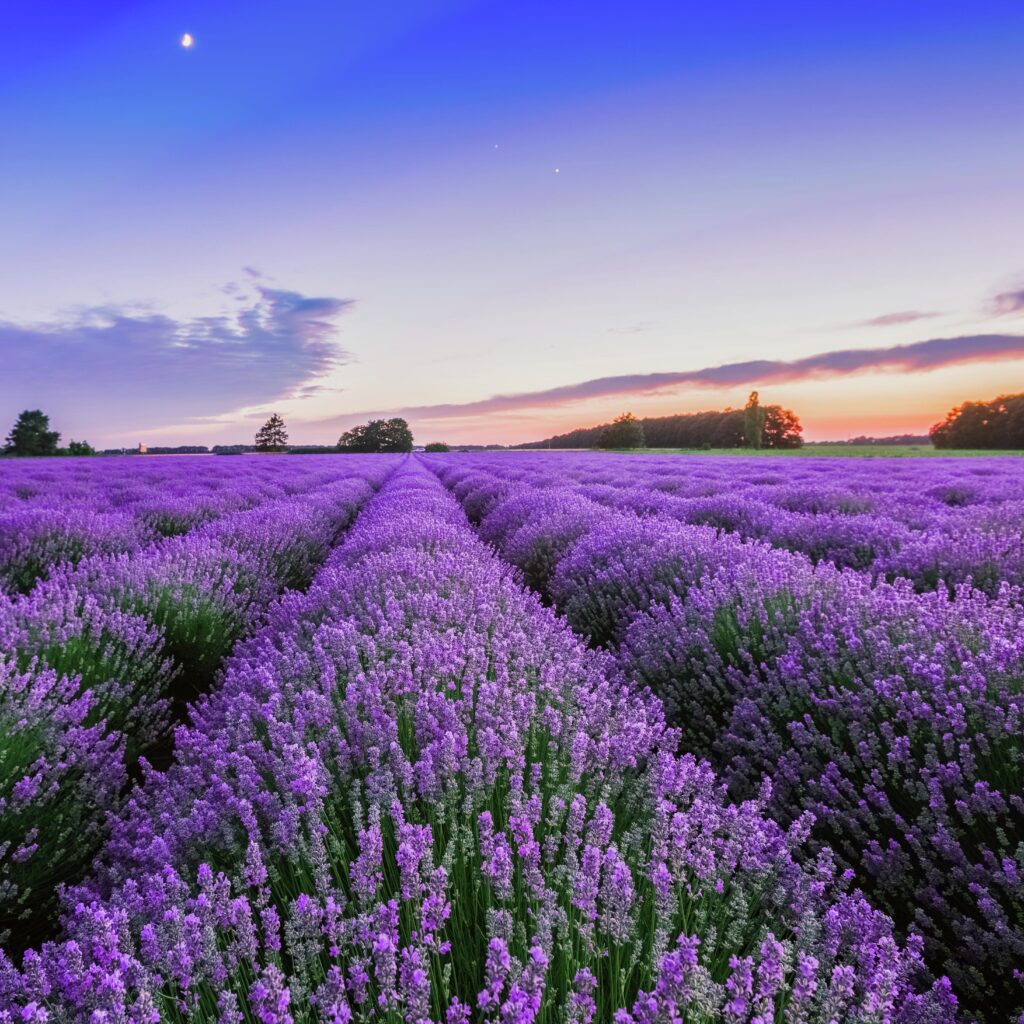
Lavender is drought-tolerant once established, but proper watering during the first year is essential:
- Initial Establishment: Water young plants 1–2 times per week.
- Mature Plants: Reduce watering to once every 2–3 weeks during dry spells.
- Avoid Overwatering: Excess moisture can lead to root rot.
Drip irrigation systems are ideal for lavender fields, providing consistent moisture to the roots without wetting foliage.
Fertilization
Lavender requires minimal fertilization:
- Use a low-nitrogen, balanced fertilizer once or twice per year.
- Over-fertilization promotes leafy growth rather than flowers.
- Mulch lightly with organic matter to retain soil moisture and regulate temperature.
Regular soil testing can help determine nutrient needs and prevent over-fertilization.
Pruning and Maintenance
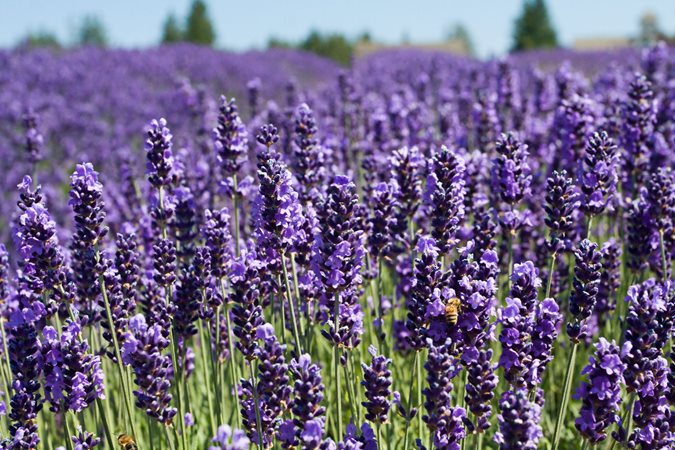
Pruning is essential to maintain shape, encourage new growth, and prolong the life of the plants:
- Annual Pruning: After flowering, trim 1/3 of the plant to prevent woody stems from taking over.
- Shaping: Maintain a rounded, compact shape for better airflow and aesthetics.
- Deadheading: Remove spent flowers to encourage a tidy appearance and improve air circulation.
Avoid cutting into old wood, as lavender may not regrow from older stems.
Pest and Disease Management
Lavender is relatively pest-resistant, but occasional problems include:
- Root Rot: Caused by poor drainage; prevent by planting in well-drained soil.
- Gray Mold (Botrytis): Occurs in humid conditions; prune affected areas and ensure airflow.
- Aphids: Small insects feeding on tender shoots; treat with insecticidal soap or water sprays.
Regular monitoring and good cultural practices reduce the likelihood of major pest or disease issues.
Harvesting Lavender
Harvesting is crucial for both ornamental use and essential oil production:
- Timing: Harvest just before full bloom when flowers are most fragrant and colorful.
- Method: Use sharp shears to cut flower spikes, leaving about 6 inches of stem above the woody base.
- Drying: Hang bundles upside down in a dark, dry, and ventilated area to preserve color and fragrance.
- Essential Oil: Steam distillation is commonly used for extracting lavender oil commercially.
Harvesting encourages additional blooms in some varieties and ensures long-term plant health.
Uses of Lavender
- Aromatherapy: Essential oils relieve stress and promote relaxation.
- Culinary: Add dried flowers to teas, desserts, or infused syrups.
- Crafts: Dried lavender is perfect for sachets, wreaths, and home décor.
- Medicinal: Traditional uses include soothing minor burns, headaches, and insect bites.
Growing your own lavender fields gives you fresh, high-quality flowers and leaves for multiple purposes.
Seasonal Care
- Spring: Monitor growth, water if needed, and fertilize lightly.
- Summer: Enjoy blooms, harvest flowers for drying or culinary use.
- Fall: Prune lightly and remove dead plant material.
- Winter: Protect young plants from frost with mulch or covers; mature plants are generally hardy.
Proper seasonal care ensures that lavender plants remain productive and healthy year after year.
Conclusion
Creating and maintaining lavender fields requires careful planning, proper site selection, and ongoing care, but the rewards are immense. With their aromatic blooms, pollinator-friendly nature, and versatility for culinary, medicinal, and decorative uses, lavender fields are a garden centerpiece that delights the senses.
By following this guide—choosing the right variety, preparing well-drained soil, planting correctly, managing irrigation and fertilization, pruning annually, and monitoring for pests—you can enjoy a thriving, fragrant lavender field for years to come.
Whether planting a small garden patch or establishing a commercial lavender farm, these practices ensure healthy plants, abundant blooms, and a beautiful landscape filled with the calming scent and vibrant colors of lavender.
